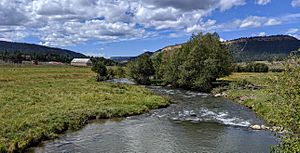Navajo River facts for kids
Quick facts for kids Navajo RiverLóolahó |
|
|---|---|
| Physical characteristics | |
| Main source | 37°15′12″N 106°38′43″W / 37.25333°N 106.64528°W |
| River mouth | Confluence with San Juan 6,319 ft (1,926 m) 37°01′26″N 107°09′31″W / 37.02389°N 107.15861°W |
| Basin features | |
| Progression | San Juan—Colorado |
The Navajo River (called Lóolahó in the Apache language) is a river about 54-mile-long (87 km) in the southwestern United States. It is an important branch, or tributary, of the San Juan River. The Navajo River starts high up in the mountains of the South San Juan Wilderness in Colorado. From there, it flows through beautiful landscapes, crossing into New Mexico before joining the larger San Juan River.
The Navajo River begins its journey in Conejos County, Colorado. This area is part of the South San Juan Wilderness, a wild and protected place. As the river flows southwest, it passes by a small community called Chromo, Colorado.
After leaving Colorado, the Navajo River dips into New Mexico. It flows just north of the town of Dulce. Then, the river turns northwest and heads back towards Colorado. Its journey ends when it meets the San Juan River in Archuleta County, Colorado.
Water for People: The San Juan–Chama Project
A very important part of the Navajo River's story is how its water is used. A lot of its water is moved to a different river system as part of something called the San Juan–Chama Project. This project is a big system of tunnels and canals. It helps move water from rivers that flow into the Colorado River basin to rivers that flow into the Rio Grande basin.
Think of it like this: the Continental Divide is a high ridge of mountains. Rivers on one side flow to the Pacific Ocean, and rivers on the other side flow to the Atlantic Ocean (or the Gulf of Mexico). The San Juan–Chama Project moves water from the Navajo River, which would normally go to the Pacific, across this divide to the Rio Grande, which flows to the Atlantic. This water is then used by people for drinking, farming, and other needs in areas that don't have enough water. It's a way to share water resources between different parts of the country.



